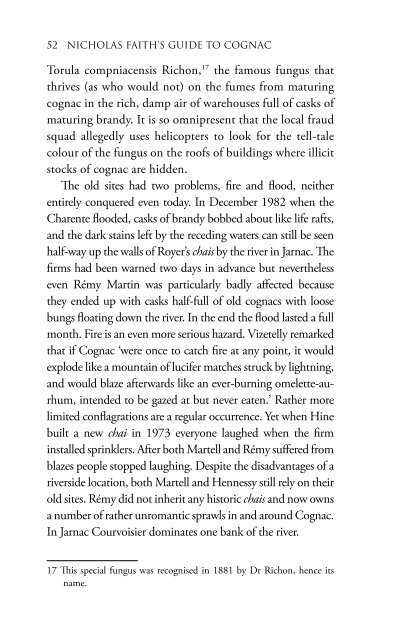Create successful ePaper yourself
Turn your PDF publications into a flip-book with our unique Google optimized e-Paper software.
Torula compniacensis Richon, 17 the famous fungus that<br />
thrives (as who would not) on the fumes from maturing<br />
cognac in the rich, damp air of warehouses full of casks of<br />
maturing brandy. It is so omnipresent that the local fraud<br />
squad allegedly uses helicopters to look for the tell-tale<br />
colour of the fungus on the roofs of buildings where illicit<br />
stocks of cognac are hidden.<br />
The old sites had two problems, fire and flood, neither<br />
entirely conquered even today. In December 1982 when the<br />
Charente flooded, casks of brandy bobbed about like life rafts,<br />
and the dark stains left by the receding waters can still be seen<br />
half-way up the walls of Royer’s chais by the river in Jarnac. The<br />
firms had been warned two days in advance but nevertheless<br />
even Rémy Martin was particularly badly affected because<br />
they ended up with casks half-full of old cognacs with loose<br />
bungs floating down the river. In the end the flood lasted a full<br />
month. Fire is an even more serious hazard. Vizetelly remarked<br />
that if <strong>Cognac</strong> ‘were once to catch fire at any point, it would<br />
explode like a mountain of lucifer matches struck by lightning,<br />
and would blaze afterwards like an ever-burning omelette-aurhum,<br />
intended to be gazed at but never eaten.’ Rather more<br />
limited conflagrations are a regular occurrence. Yet when Hine<br />
built a new chai in 1973 everyone laughed when the firm<br />
installed sprinklers. After both Martell and Rémy suffered from<br />
blazes people stopped laughing. Despite the disadvantages of a<br />
riverside location, both Martell and Hennessy still rely on their<br />
old sites. Rémy did not inherit any historic chais and now owns<br />
a number of rather unromantic sprawls in and around <strong>Cognac</strong>.<br />
In Jarnac Courvoisier dominates one bank of the river.<br />
17 This special fungus was recognised in 1881 by Dr Richon, hence its<br />
name.<br />
Of course there are many tricks to the trade when<br />
preparing cognacs for sale. For instance, they can be<br />
returned to new oak for a few months to give them a final<br />
boost of tannin and then put back into old casks to avoid<br />
too much hardness. Since the arrival of the appellation<br />
system the merchants are limited in the ability to tamper<br />
with their cognacs. They can add as much boisé as they like<br />
and 8 grams of sugar per litre but only one part of caramel.<br />
Unmentionable is the alleged use of artificial flavours<br />
imported by a handful of unscrupulous houses from Dutch<br />
fragrance manufacturers. Some merchants disguise the lack<br />
of any specific character in their cognacs with relatively<br />
heavy doses of caramel, but this can easily be detected from<br />
the rawness of the alcohol and the burning sensation it<br />
leaves on the palate. But because the sugars from the hemicellulose<br />
in the wood gradually infiltrate the cognac after<br />
twenty years, Hennessy for one, finds that it has to put<br />
only 2 grams of sugar, a quarter of the permitted level, into<br />
each litre – the Tesserons say that they have only 2 parts in<br />
10,000 in their cognacs. The sugary syrup softens the young<br />
cognacs and ‘rounds’ them, while the caramel, neutral to<br />
the taste, merely standardises the colour. Nevertheless, the<br />
best accolade Charles Walter Berry could give to an 1830<br />
cognac was that it was ‘pure’ and had ‘never been touched<br />
or refreshed’.<br />
Because the Chinese and the Japanese equate darkness<br />
with age, the blends sent to the Far East may well be darker<br />
than those sold in Europe or the United States. They also<br />
tend to be richer so that they can be diluted through<br />
mixing with ice without losing their flavour. The Japanese,<br />
for instance, were unhappy at the dry intensity of Martell’s<br />
cognacs. And there’s a new phenomenon – the many blends


